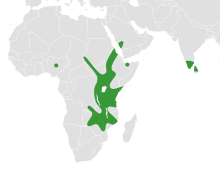
The Faboideae are a subfamily of the flowering plant family Fabaceae or Leguminosae. An acceptable alternative name for the subfamily is Papilionoideae, or Papilionaceae when this group of plants is treated as a family.

Phaseolus is a genus of herbaceous to woody annual and perennial vines in the family Fabaceae containing about 70 plant species, all native to the Americas, primarily Mesoamerica.

Vigna is a genus of plants in the legume family, Fabaceae, with a pantropical distribution. It includes some well-known cultivated species, including many types of beans. Some are former members of the genus Phaseolus. According to Hortus Third, Vigna differs from Phaseolus in biochemistry and pollen structure, and in details of the style and stipules.

The plant tribe Phaseoleae is one of the subdivisions of the legume subfamily Faboideae, in the unranked NPAAA clade. This group includes many of the beans cultivated for human and animal food, most importantly from the genera Glycine, Phaseolus, and Vigna.
Condylostylis is a small genus of flowering plants in the legume family, Fabaceae. It belongs to subfamily Faboideae. The genus includes four species native to the tropical Americas, ranging from southeastern Mexico to northern Argentina. Species in this genus were formerly considered to belong to the genus Vigna.
Dolichopsis is a small genus of flowering plants in the legume family, Fabaceae. It belongs to the subfamily Faboideae. It includes three species native to South America, ranging from west-central and southeastern Brazil to Bolivia, Paraguay, and northern Argentina.

Leptospron is a small genus of flowering plants in the legume family, Fabaceae. It contains two species with a pantropical distribution. It belongs to the subfamily Faboideae. Species in this genus were formerly considered to belong to the genus Vigna.
Mysanthus uleanus is a species of flowering plant in the legume family, Fabaceae. It is a climbing herb endemic to eastern Brazil. It grows in seasonally-dry tropical wooded grassland, thorn scrub, rocky shrubland, and in degraded areas. It is the only described member of the genus Mysanthus, though there is a report of an undescribed species. The genus belongs to subfamily Faboideae.

Oxyrhynchus is a small genus of flowering plants in the legume family, Fabaceae. It includes four species, three native to the tropical Americas from northern Mexico to Colombia, and one native to New Guinea, Maluku, and the Bismarck Archipelago. It belongs to the subfamily Faboideae. A key for the species in this genus has been published.
Pictetia is a genus of about eight species of trees and shrubs in the family Fabaceae with spiny stems and spine-tipped leaflets. The genus is endemic to the Greater Antilles, but its closest relatives are in Mesoamerica and Africa.

Sigmoidotropis is a genus of flowering plants in the legume family, Fabaceae. It includes eight species native to the tropical Americas, ranging from northern Mexico and the Caribbean islands to southern Brazil. It belongs to the subfamily Faboideae. Species in this genus were formerly considered to belong to the genus Vigna.

Strophostyles is monophyletic three-species genus of flowering plants in the family Fabaceae, subfamily Faboideae. Common names for the genus include wild bean and fuzzybean. It consists of annual and perennial herbaceous vines, ranging in their native distribution from Nevada, east to Florida, and north to the Great Lakes and eastern Canada. The etymology of the name is strophe (turning) + stylos (style), referring to the curve of the style within the keel petal.

The tribe Dalbergieae is an early-branching clade within the flowering plant subfamily Faboideae. Within that subfamily, it belongs to an unranked clade called the dalbergioids. It was recently revised to include many genera formerly placed in tribes Adesmieae and Aeschynomeneae and to be included in a monophyletic group informally known as the dalbergioids sensu lato. The members of this tribe have a distinctive root nodule morphology, often referred to as an "aeschynomenoid" or "dalbergioid" nodule.

Ancistrotropis is a genus of flowering plants in the legume family, Fabaceae. It belongs to the subfamily Faboideae. Species in this genus were formerly considered to belong to the genus Vigna.

Cochliasanthus caracalla is a leguminous flowering plant in the family Fabaceae that originates in tropical South America and Central America. The species is named caracalla, a corruption of the Portuguese caracol, meaning snail.
Helicotropis is a small genus of flowering plants in the legume family, Fabaceae. It belongs to the subfamily Faboideae. It includes three species of perennial climbing vines native to the tropical Americas, ranging from southern Mexico to northeastern Argentina. Species in this genus were formerly considered to belong to the genus Vigna.

Ramirezella is a small genus of flowering plants in the family Fabaceae. It includes seven species of climbing herbs native to southern North America, ranging from northern Mexico and Nicaragua. Typical habitats include seasonally-dry tropical forest and secondary vegetation in disturbed areas. It belongs to the subfamily Faboideae.

Limadendron is a genus of small trees in the family Fabaceae. It includes two species native to northern South America, including Colombia, Venezuela, the Guianas, northern Brazil, and Peru. The genus was recently separated from the genus Poecilanthe. It belongs to the tribe Brongniartieae.














